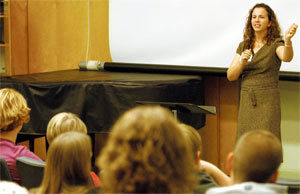November 10, 2004
The School of Rock
by Dawn Morrison
 | ||
| 蘑菇AV continues to attract outstanding academics who strengthen our capacity for excellence in research and learning. From Elvis Presley to the White Stripes, rock and roll is the medium and the message for Dr. Jacqueline Warwick. Abriel photo | ||
Mick Jagger sang "it's only rock and roll," but in Dr. Jacqueline Warwick's class, it is much more. One of 蘑菇AV's newest professors, Dr. Warwick is an expert on popular music, from the beginnings of rock and roll; right up to today's dance and hip hop styles.
Ask Dr. Warwick about the importance of music, and she is as comfortable talking about influential 50's blues shouter Big Momma Thornton, as she is discussing Beyonce or The White Stripes. Dr. Warwick teaches two popular music classes: The History of Rock and Roll, and The Rock and Roll Era and Beyond. In her classes, students analyze and learn from diverse musical performers from the last hundred years.
Some may be surprised that rock and roll is studied at 蘑菇AV, but this form of music serves as unique record of our history, culture and changing social values. "Taking rock and roll seriously is relatively new, but the study of popular music is an expanding area of musicology," says Dr. Warwick. "Some think that we are teaching music appreciation, but that is not what studying popular music is all about. Music is a document that can be used to further our knowledge of history, culture, and changing social values, whether we are studying Mozart, Elvis, or Fatboy Slim."
We couldn't resist asking an expert on popular music to dish about pop and rock stars - past and present. Here are Dr. Warwick's thoughts on some of the biggest names in music. See how many you recognize: Led Zepplin: The first thing that comes to mind is their strong connection to the blues. British rockers in the '60s like Led Zepplin, Eric Clapton, Cream and the Rolling Stones would find these 30-year-old recordings from African American bluesmen, and it would blow their minds. Often, band members' interest in the blues would be the unifying force that drew them together, and bonded them as a group. The White Stripes: I enjoy the energy, and the stripped-down, gritty sound of current bands like the White Stripes and Jet. There is a lot of irony in their sound, which is perhaps a strong differentiating factor between them and the 60's British rock acts they are emulating. Outkast: Probably the most influential hip hop artists around at the moment, although they are moving away from a traditional hip hop sound. Their latest album was huge, and had some great tracks on it. Hanson: When that "Mmm Bop" song was popular a few years ago, it certainly held an annoyance factor for some people, and there was a time when I couldn't listen to it. But looking back, that was a great song, tapping into the rock and roll style of the '60s. Public Enemy: Hip Hop really began as party music back in the late 1970s, but Public Enemy took that form and used it to talk about social issues in a really constructive way. Lindsay Lohan/Hillary Duff: These pop stars connect back to the 1950s, when actresses like Annette Funicello were getting contracts and putting out records to an established audience. Like Funicello, with these singers, the emphasis is on their "girl next door" qualities, and not necessarily on virtuosity or originality in the music. They convey the message that they are ordinary girls, just like their fans, but lucky enough to be pop stars. This gives the idea that their fans could achieve this, too. |
At 蘑菇AV's recent Open House, Dr. Warwick gave a taste of her course to a packed classroom. She played an audio recording of Big Momma Thornton singing Hound Dog, the song made famous by Elvis Presley. This began a discussion of not only their different musical styles, but also the historical and societal events that shaped the mid to late 1950's. "Music is a site of struggle and celebration. It has a lot of significance for society and the human experience," she says, adding that Elvis' controversial first appearances on television shocked the nation, and became a revolutionary moment for the time. "Music not only reflects what is happening socially, but can also sometimes shape it."
To illustrate how revolutionary Elvis was, consider that songs like Patti Page's "How Much is that Doggy in the Window" were the kind of music that dominated the charts when he rose to fame. In teaching students about the influence of Elvis, Dr. Warwick can also point to elements of American race relations in the 50s, which coincided with his meteoric rise to fame. Although Elvis is long considered the King of Rock and Roll, she points out, the genre existed for decades previously, but had been considered "black" music and relegated to the margins of popular music. Elvis brought this blues-influenced music into the mainstream, but artists like Chuck Berry and Little Richard were doing it long before Elvis ever swiveled a hip. The single biggest musical influence today, she says, is hip hop, which she says currently influences just about every type of music performer.
Whether it's today's dance-inspired, hip hop music, or echoes of our musical past, Dr. Warwick's classes prove there is more to rock and roll than meets the ear. With apologies to Mick, judging from the students flocking to her classes, it's safe to say that they like it, like it (yes, they do).
Jacqueline Warwick is working on a book, soon to be published by Routledge Press, entitled: Girl Groups, Girl Culture: Popular Music and Identity in the 1960s. She is the founding editor of the online publication ECHO: a music-centered journal.
